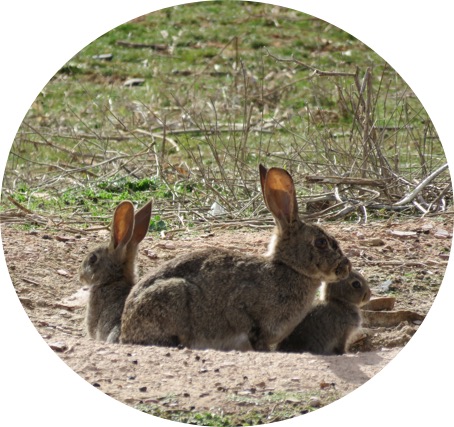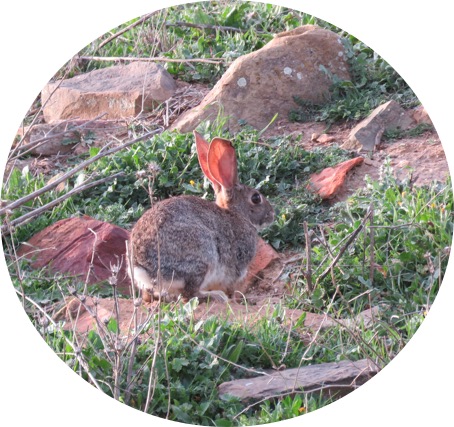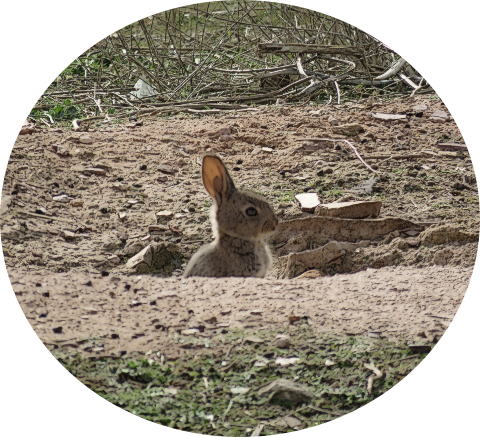THE RABBIT
The European rabbit belongs to the family Leporidae (hares and rabbits) and probably evolved during the Middle Pleistocene in the south-east of the Iberian Peninsula.
Its wide range, abundance and size ensure that in the Iberian Peninsula over 40 species of birds and mammals depend on the rabbit as prey; specifically, it is the main prey item of iconic species such as the Iberian lynx and Iberian imperial eagle. Furthermore, Its abundance and the excellent quality of its flesh mean that it is habitually consumed by humans and is traditionally the commonest small game species in both Spain and Portugal.

Rabbits are true ecosystem engineers due both to their mechanical role in excavating their burrows and warrens, and the way in which they modify the structure of pastures and scrub formations.
As well, their excrements also contribute to improving soil quality and help disperse seeds. The rabbit is regarded as a multifunctional keystone species in Mediterranean ecosystems in the Iberian Peninsula given the role it plays in modulating the landscapes and as a seed disperser, and as a prey item for numerous carnivore species.
It has large ears up to 7 cm in length and a very short tail. Its back legs are very strong and well adapted to running. An adult rabbit weighs between 1.5 and 2.5 kg.
FOOD

BREEDING
The wild rabbit is a prolific breeder and is one of the few vertebrate species whose females are fertile all year around. The factor which determines whether or not female rabbits are on heat is the quality and quantity of the food they consume since the proteins that doe rabbits ingest will influence and determine her capacity to breed. As well, the amount of water that her food contains will also directly affect her ability to produce milk for her kittens.
Thus, if the proteins in her food are lacking or of poor quality, the doe will breed badly or not at all. If there is little water in her diet, she will not be able to feed her young and she will lose her brood. Poor-quality food in summer will prevent her from becoming fertile and/or gestating in autumn, and reduce the size of her broods.
As a result, rabbits’ breeding periods depend on the quality and abundance of the pastures where they graze. Breeding takes place most often in the months between November and June.
The average life expectancy of rabbits is short, around 1.2 years. This is offset by its great reproductive potential – 3–6 young in each brood – and the fact that rabbits become sexually mature just a few months after being born.
REFUGES
Although rabbits are found in a wide variety of environments, they are most abundant in Mediterranean scrubland, above all if there are cultivated areas nearby and the landscape is flat or gently rolling.
Aside from the cover afforded naturally by areas of scrub and rocks, their warrens play key roles as places for taking shelter, above all if the shrub layer is poor.

Rabbits usually live in social groups whose size will depend on the size of the warren, as well as the structure and quality of the habitat. Their warrens are essential for maintaining rabbit populations and they tend not to move too far from them. Young rabbits depend totally on their warrens and their size and complexity will determine how many rabbits can live there and the number of young they can produce.
It has been seen that rabbits will tend to excavate and maintain larger warrens in areas that lack shelter; on the other hand, in areas with a good scrub cover such as wood pastures, rabbits live in smaller warrens with fewer galleries than in more open areas.
Their warrens tend to be placed in transitional or contact areas between scrub and pastures or cultivated fields. They can be excavated under the shade of a tree or tall shrub, and take advantage of the natural gaps between roots. In zones of granite soils, rabbits benefit from the spaces between rocks to excavate their warrens, which give them great stability and protection from potential predators. In agricultural areas where there is little cover, they build their warrens along field edges and in fallow, river margins and even large banks created by human infrastructures.
Around the warrens females set up breeding burrows where subordinate females raise their young. They tend to consist of just a tunnel near the surface that the female will cover over when she goes out to feed or defecate.
Finally, it is worth noting that some rabbit populations tend to live above ground and take advantage of gaps in the vegetation, and so do not build complex warrens. This occurs, for example, in areas of the Montes de Toledo, Las Villuercas and the western part of the Sierra Morena.
ORGANIZATION AND BEHAVIOUR
In general, rabbits live in social groups whose size will depend on the size of the warren. Social hierarchies are established amongst both male and female rabbits and between adult and young rabbits. Dominant males mate with the highest ranking females, while the lowest ranking females are left to construct their breeding chambers in burrows in the least protected areas or, even, outside the warren. Territories are defended above all by the dominant male, although all group members will participate in defensive duties if necessary.
Rabbit activity is directly influenced by the structure of predator communities. In the Iberian Peninsula rabbits’ daily routines are basically bimodal, with activity peaks at dusk and moderate activity at night. On the other hand, in areas in which rabbits have been introduced and there is less danger of predation no clear behavioural patterns are discerned.


